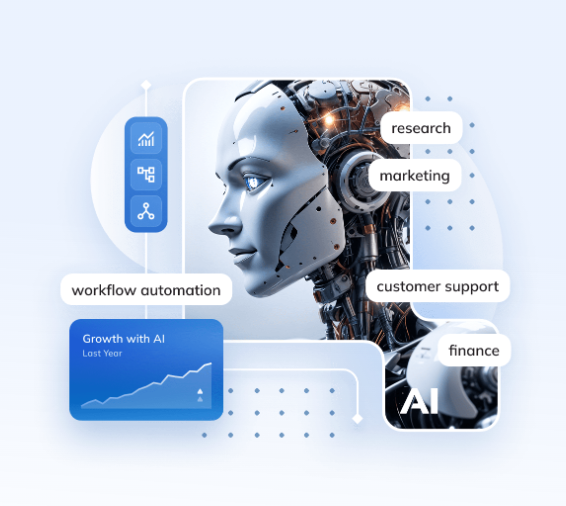Building Personalized AI Agents for Customer Support: A Step-by-Step Guide

In the rapidly evolving world of customer service, businesses are increasingly relying on Artificial Intelligence (AI) to enhance user experience, streamline operations, and provide personalized support at scale. AI agents, also known as chatbots or virtual assistants, are a powerful tool for automating customer interactions while maintaining a human-like touch. Personalized AI agents, in particular, can engage customers in a tailored manner, ensuring each individual feels heard, understood, and assisted in a way that suits their needs.
This article serves as a step-by-step guide on how to build personalized AI agents for customer support, from concept to execution, covering everything from understanding customer needs to AI agent development and deployment.
1. Understanding the Importance of Personalized AI Agents
Personalized AI agents go beyond generic responses, offering tailored experiences based on individual customer behavior, preferences, and historical interactions. This personalization can significantly enhance customer satisfaction by:
-
Speeding up Response Times: AI agents can respond instantly, 24/7, without any downtime.
-
Improving Efficiency: AI can handle repetitive tasks like FAQs, order tracking, and appointment scheduling, freeing up human agents for more complex queries.
-
Enhancing User Experience: By tailoring responses based on user data, AI agents create more meaningful and relevant interactions, leading to a better overall experience.
For companies, AI agents not only help improve service levels but also reduce operational costs and increase scalability. Personalized AI agents can learn over time, adapting to customer queries and refining their responses to offer even more relevant assistance in the future.
2. Setting Up Your Personalized AI Agent for Customer Support
Building a personalized AI agent requires a systematic approach. The first step involves identifying your goals and understanding the key aspects of your customer support strategy.
Step 1: Identify Customer Needs and Business Objectives
Before diving into the technical aspects of AI agent development, it is essential to understand your business objectives and the needs of your customers. Conducting surveys or gathering feedback from your customer support teams can help identify the most common customer pain points and the tasks that are ideal for automation. For example, you may want the AI to:
-
Provide instant answers to frequently asked questions.
-
Help customers place orders or track shipments.
-
Collect customer feedback or handle basic troubleshooting.
Once you’ve identified the core functionalities of your AI agent, the next step is to understand your customers’ behaviors and preferences. Are they likely to need assistance with account management or product inquiries? Do they prefer to interact through text or voice?
Step 2: Collect Customer Data
Personalization is at the heart of this process, and it begins with gathering the right data. AI agents learn from data to offer tailored solutions. Start by collecting customer data, such as:
-
User Profiles: Information like purchase history, preferences, and previous interactions with customer support can help the AI offer personalized solutions.
-
Behavioral Data: Tracking how customers interact with your website or app provides insights into their needs and preferences.
-
Feedback and Ratings: Incorporate direct customer feedback from support surveys, ratings, or other sources to enhance the AI’s understanding of customer satisfaction levels.
This data will serve as the foundation for building an AI agent that can adapt and evolve based on real-time interactions.
3. Designing the Personalized AI Agent
The next step is designing the structure and personality of your AI agent. The key here is to create an agent that is not only functional but also engaging and capable of delivering personalized experiences.
Step 3: Choose the Right AI Technology
Building a personalized AI agent involves selecting the right tools and platforms that can handle complex tasks such as Natural Language Processing (NLP), machine learning (ML), and integration with other systems. Some popular tools include:
-
Google Dialogflow: A tool that allows you to create conversational interfaces powered by Google’s NLP capabilities.
-
Microsoft Bot Framework: A comprehensive platform for building AI-powered chatbots, offering deep integration with Microsoft products.
-
Amazon Lex: An AI service that powers Amazon Alexa and allows you to create sophisticated conversational interfaces.
-
IBM Watson: Known for its AI and NLP capabilities, Watson helps build intelligent chatbots that can understand customer queries and deliver personalized experiences.
Step 4: Define the AI’s Personality
A personalized AI agent should have a distinct personality to engage users more effectively. Whether your AI adopts a formal tone or a more friendly and casual one depends on your brand voice and your customers’ preferences. Consider these factors when defining the agent's persona:
-
Tone and Language: Should your AI use formal language or maintain a more relaxed, conversational tone? The personality should align with the way your customers expect to interact with your brand.
-
Customization: Can your AI use customer names, reference past interactions, or make recommendations based on previous purchases?
-
Empathy and Adaptability: Can the AI empathize with customers and adapt to their mood? For example, if a customer is frustrated, the AI should be able to recognize this and adjust its tone to a more calming and reassuring approach.
Step 5: Script and Design Conversations
Now it’s time to build the AI’s conversational flow. This includes:
-
Intent Recognition: Ensure the AI understands the different intents behind customer queries. For example, a user might ask about an order’s status, request a refund, or need technical support.
-
Dialog Trees: These are predefined pathways that guide the AI’s conversation. They should cover a variety of customer queries and offer appropriate responses, depending on the context.
-
Fallback Mechanisms: In case the AI cannot handle a query, it should be programmed to escalate the issue to a human representative. A personalized AI agent should also have fallback options to offer alternatives like suggesting knowledge base articles.
Incorporating machine learning (ML) at this stage can help the AI agent evolve by learning from customer interactions and improving its accuracy and response quality over time.
4. Integrating the AI Agent with Your Existing Systems
For your AI agent to function effectively, it must be integrated with your existing customer support systems. This includes your customer relationship management (CRM) platform, ticketing system, databases, and even third-party services. Seamless integration ensures that your AI agent has access to the necessary information to respond to customer queries promptly and accurately.
Step 6: Connect AI to Databases and CRM
Personalized responses often depend on access to a user’s account information, order history, or preferences. By integrating your AI with your CRM system, the agent can retrieve relevant data to offer tailored responses, such as:
-
Account details
-
Order status
-
Previous support interactions
Moreover, this integration can help the AI provide proactive support by reminding customers of upcoming renewals, payment due dates, or discounts based on their preferences.
Step 7: Use Analytics and Feedback Loops
To continually improve the personalized AI agent, you should implement feedback loops that collect data on how the agent is performing. By monitoring customer interactions and analyzing metrics such as response time, satisfaction scores, and resolution rates, you can make improvements to the AI’s responses and performance.
5. Testing and Refining Your Personalized AI Agent
Before rolling out your personalized AI agent to customers, it’s essential to conduct thorough testing.
Step 8: Pilot Testing
Pilot testing involves releasing the AI agent to a small group of customers, allowing them to interact with it and provide feedback. This testing phase helps identify any bugs, gaps in the conversation flow, or opportunities for improvement.
Step 9: Refine and Optimize
Based on the feedback and insights gathered during testing, refine your AI agent to enhance its performance. This could involve:
-
Adjusting the conversational tone: If users find the AI too formal or too casual, adjust accordingly.
-
Improving accuracy: Fine-tune the NLP model to improve intent recognition and response accuracy.
-
Enhancing personalization: Add more personalized elements, such as proactive assistance based on user behavior or preferences.
6. Deploying and Scaling Your AI Agent
Once the AI agent is ready and optimized, it’s time for deployment. Ensure that the agent is available across all relevant customer touchpoints, including your website, mobile app, social media platforms, and messaging channels like WhatsApp or Facebook Messenger.
Step 10: Continuous Monitoring and Improvement
Once deployed, it’s crucial to continuously monitor the AI agent’s performance. Regularly update it with new data and fine-tune its responses to keep it relevant. AI agents should evolve over time, adapting to customer behaviors and addressing emerging challenges.
Conclusion
Building a personalized AI agent for customer support is a process that requires careful planning, development, and testing. From understanding your customers' needs to selecting the right tools for AI agent development, each step is crucial to ensuring the success of your virtual assistant. By combining the power of machine learning and personalized data, you can build an AI agent that not only improves efficiency but also enhances the customer experience.
- Industry
- Art
- Causes
- Crafts
- Dance
- Drinks
- Film
- Fitness
- Food
- Games
- Gardening
- Health
- Home
- Literature
- Music
- Networking
- Other
- Party
- Religion
- Shopping
- Sports
- Theater
- Wellness
- News


